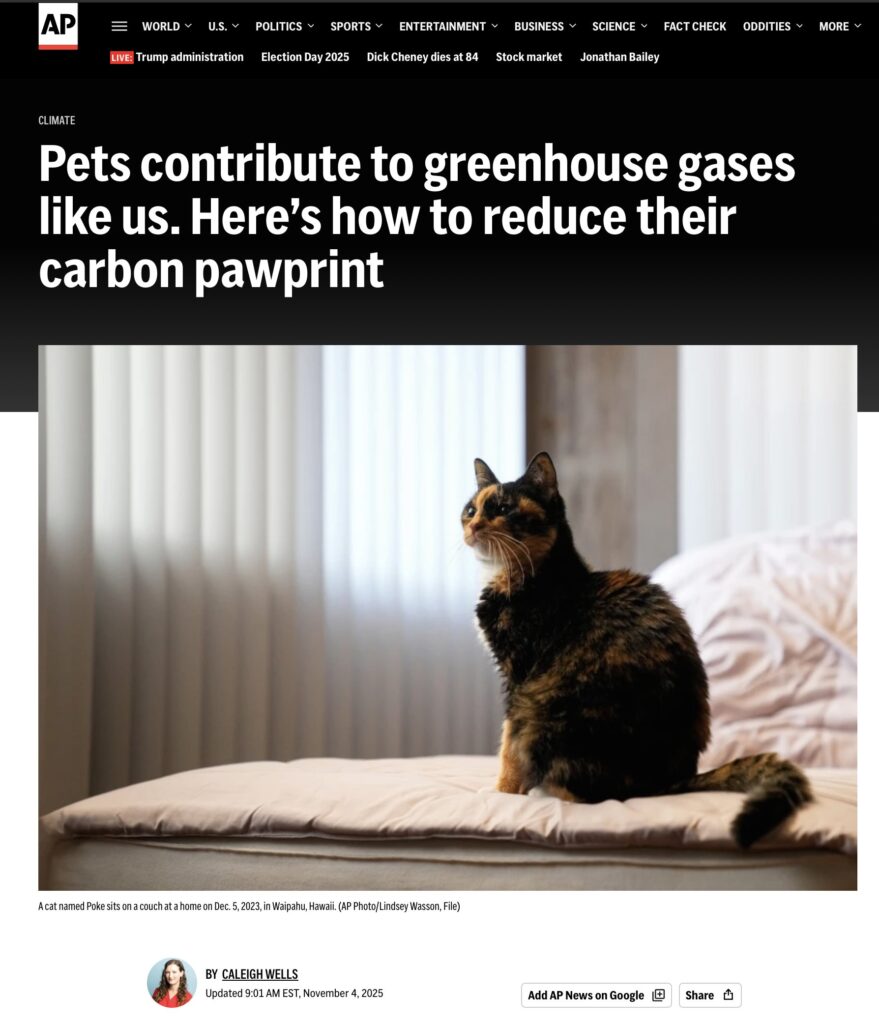Pets have a pretty sizable climate impact. But not all carbon…pawprints…are created equal. So if you’re looking to get a pet, which ones emit the least? And if you’ve already got one, how do you make sure it has the smallest foot (or paw) print? There are some options. pic.twitter.com/T7jliUMF0d
— The Associated Press (@AP) November 4, 2025
BY CALEIGH WELLS
The whole “pets are family members” idea isn’t just a sweet sentiment. Data shows that pet owners are increasingly buying food that resembles their own diets.
The trend toward refrigerated, “fresh” or even “human-grade” pet food can come with a price beyond the pet food budget.
One of the most climate intensive decisions we make is whether to own a pet. It’s for the same reason that humans have a big impact: They eat every day. And most of them eat meat. The environmental impact of meat includes the land the animal lived on, the food it ate, the waste it generated and other factors.
0 seconds of 58 secondsVolume 90%
“What else do pets do? We have to feed them. I think that that’s why it’s number one,” said Allison Reser, director of sustainability and innovation at the Pet Sustainability Coalition.
But just like people, a pet’s impact on the planet can vary greatly depending on their diet.
Does human-grade mean better?
The marketing of higher-quality pet food suggests that it’s healthier.
But there isn’t much evidence to suggest refrigerated, fresh or human-grade food leads to better pet health outcomes, according to Alison Manchester, assistant clinical sciences professor at Cornell University’s College of Veterinary Medicine.
“I think a lot of it is playing on marketing and treating pets as members of the family,” said Manchester.
She said traditional kibble and wet food can also provide a perfectly balanced pet diet, and it often makes use of animal parts that aren’t palatable to humans and otherwise might have been wasted.
Billy Nicholles, pet food researcher with Bryant Research, said the trend of using human-grade meat in pet food increases its climate impact because pets aren’t just eating animal parts that would have otherwise gone unused.
“We definitely can’t dismiss these impacts altogether by just saying these are the offcuts, these are environmentally negligible,” he said.
Reducing your pet’s climate pawprint
In the U.S., feeding dogs and cats accounts for more than a quarter of the environmental impact from meat consumption. The pollution created from the meat that dogs and cats consume in the U.S. is equivalent to the pollution created from driving 13.6 million cars for a year, according to a UCLA study.
One common and easily-solved problem is giving less food to overweight pets.
“Not only does (overfeeding) mean that the dog’s going to have a poorer quality of health,” Nicholles said. “It also means that we’re increasing to those environmental impacts as well.”
…
Pets have zero impact on the climate.
Zero.
This is made up, fabricated BS.
Climate extremists have waged a war on energy, meat consumption, procreation, and now pets. There is not one aspect of your life that these radicals don’t seek to control.
This is a con job. https://t.co/1zDONyA41k
— Chris Martz (@ChrisMartzWX) November 4, 2025




